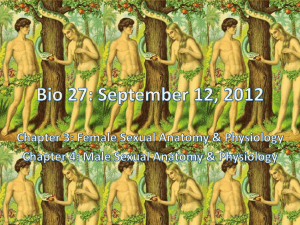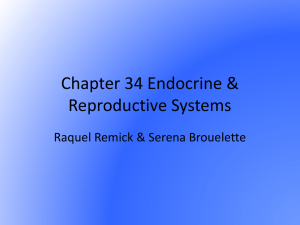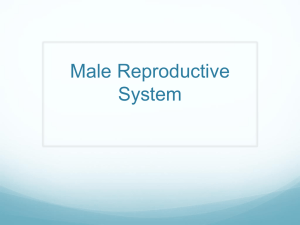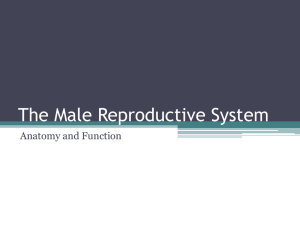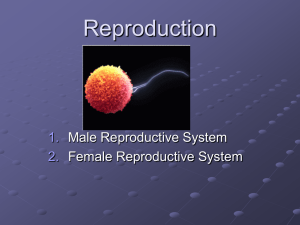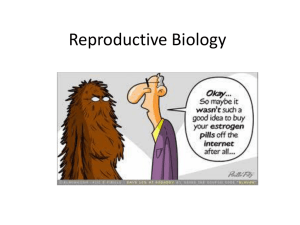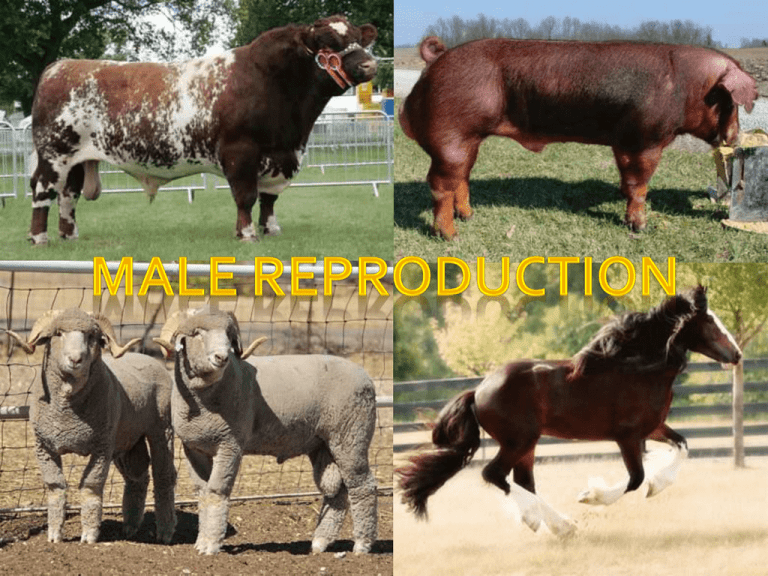
Function:
Produce and deliver fertile sperm to the female
reproductive tract
Produce the hormone Testosterone
Job:
Fertilize the female egg
Fibroelastic Penis vs. Vascular Penis
Fibroelastic: uses the sigmoid flexure and retractor muscle
to become erect
Vascular: will fill with blood to become erect
Thermoregulation: regulation of the temperature of
the testes to support fertile sperm production
Cryptorchidism: when one or neither testes descend
into the scrotum during the fetal stages
Convoluted: contains many veins
Vasectomy: procedure to sterilize a male
Spermatogenesis: formation and growth of sperm
Testosterone
Produced by:
▪ Leydig Cells (found in the testicles)
Function:
▪ Promotes spermatogensis
▪ Promotes secondary sex characteristics
▪ Example: horn growth or bright colored feathers in male birds
Important Organs:
Scrotum
▪ Tunica Dartos
Spermatic Cord
▪ Ductus Deferens/Vas Deferens
▪ Pampiniform Plexus
▪ Cremaster Muscle
Testicles
Epididymis
Penis
▪ Fibroelastic vs. Vascular
Houses the testes
Function:
Tunica Dartos
Protection
Temperature Regulation
(thermoregulation)
Movement of the testes
Layers:
Skin
Epididymis
Skin
▪ Sweat Glands located here
▪ Thermal Receptors
Tunica Dartos Muscle
▪ Assists in thermoregulation
Testes
Description: highly convoluted
Function:
Suspend the testes in the scrotum
Provide heat cooling system
Houses:
Ductus Deferens/Vas Deferens:
▪ Move fertile sperm from the tail of the
epididymis to the penis for ejaculation
▪ This is cut and causes a Vasectomy
Pampiniform Plexus
▪ Composed of a testicular artery and
veins that cool the blood before
circulating throughout the scrotum
Cremaster muscle
▪ Supports the testes
▪ Muscle that will pull testes up during a
fight or flight situation
▪ Holds testes up for a short period of time
Pampiniform Plexus
Function:
Produce Sperm
Produce the hormone
Testosterone
Produce 1-25 Billion sperm
Must be 3-6 degrees cooler
than the body to keep
sperm alive
Takes 45-60 days to
produce fertile sperm
In the Fetal stage the testes will descend into the
scrotum
This is important for proper sperm production and
temperature control
Gubernaculum:
Pulls the testes through the Inguinal Ring into the
scrotum
Inguinal Ring:
Ring that is the opening between the body and
scrotum
Cryptorchidism:
Def: Failure of one or both of the testes to descend
through the inguinal ring into the scrotum
Unilateral Cryptorchidism: one testis does NOT
descend into the scrotum
▪ Results in reduced fertile sperm concentration NOT infertile
Bilateral Cryptorchidism: Neither testes descend into
the scrotum
▪ Results in Sterility/Infertility
Inguinal Ring
Function:
Sperm Transport
Sperm Maturation
Storage of Sperm
3 Components:
Head (Caput)
Body (Corpus)
Tail (Cauda)
Ductus Deferens
Head (Caput)
Entry point of produced sperm
from the testes
▪ Sperm are NOT motile
▪ Sperm are NOT fertile
Body (Corpus)
Maturation of Sperm
▪ Some expression of motility
▪ Some expression of fertility
Tail (Cauda)
Sperm Storage
▪
▪
▪
▪
Sperm are motile
Sperm are fertile
5-10 ejaculations are stored
Sperm can bind to an egg
Organ of fertilization of
the female
2 Types:
Fibroelastic Penis
▪ Sigmoid Flexure (S-curve)
▪ Rectractor Penis Muscle
Vascular Penis
Species Differences:
Fibroelastic Penis:
▪ Boar, Bull, and Ram
Vascular Penis
▪ Stallion and Humans
Sigmoid Flexure
Retractor Penis
Muscle
Bull
Fibroelastic Penis
Ram
Fibroelastic Penis
Filiform Appendage
Boar
Fibroelastic Penis
Nonpendulous & Inverted testicles (tail of epididymis is above
the head of the epididymis)
Cork Screw Shape (match for the sows corkscrew cervix)
Stallion
Vascular Penis
▪ Bell Shaped Penis
NO Sigmoid Flexure
Fibroelastic Penis:
Extends in length by a muscle to
penetrate the female
Retractor Muscle
▪ Helps with erection
Sigmoid Flexure
▪ ‘S curve’ that holds penis within the
body when not erected or helps
extend the penis when erected
Examples: Bull, Boar, and Ram
Species Differences:
▪ Ram:
▪ Filiform Appendage: Sprays sperm
within the vagina for better chance of
fertilization
▪ Boar:
▪ Corkscrew shaped penis: Matches the
sows corkscrew shaped cervix
Filiform appendage
Vascular Penis
Penis fills with blood to
become erect
Does NOT include sigmoid
flexure
Examples:
▪ Stallion
▪ Human
Castration
Removal of the testicles
Vasectomy
Cutting or severing of the Ductus Deferens
Shortening of Spermatic cord
Shortening of the spermatic cord to raise the
testicles closer to the body
▪ Raising the testicles closer to the body will cause the
temperature to become too hot causing sperm to die
or become sterile
Thermoregulation is important for the survival of fertile sperm
Sperm will die if:
Testes become too hot
▪ Testes need to be 3-6 degrees cooler than the body
▪ Heat will damage DNA within the sperm
▪ Heat will cause lower levels of fertility
Testes become too cold
Come in contact with blood
Ways of thermoregulation
Thermoreceptors located on the scrotum sends messages to the
brain when too hot or too cold
▪ Will cause panting to help dissipate heat from the body
Sweat glands located on the scrotum will allow for cooling
Tunica Dartos Muscle:
▪ Muscle layer beneath the skin of the scrotum will expand when too hot and
will lift the testes up towards the body if too cold
How Thermoreceptors and sweat glands
communicate with the brain
Definition: formation of Sperm
Sperm are formed and grow within
the testes
Within the testes sperm are grown
inside of the seminiferous tubules
within the lobules
2 Cell Types:
Leydig Cells:
▪ Produce testosterone
Testes
▪ Located outside the seminiferous
tubules
Sertoli Cells:
▪ Protect and aid in growing sperm
▪ Aid in Spermatogenesis
▪ Located inside the seminiferous
tubules
Ductus Deferens
1.
2.
Seminiferous Tubules
Epididymis
1. Head
2. Body
3. Tail
3.
4.
5.
Vas Deferens
Penis
Into the Female Tract
Penis
Head:
Carries the DNA
Mid-Section (neck)
Structure
Holds the head to the tail
Mid-Section
Head
Tail
Motor
Drives the sperm
throughout the male
reproductive tract and
female reproductive tract
to the site of fertilization
Tail
Sperm is measured by Volume (mL) and
Concentration (x106/mL)
Species differences:
Species
Volume (mL)
Concentration
(x106/mL)
Ram
1
2000
Bull
10
1000
Stallion
100
500
Boar
200
250


